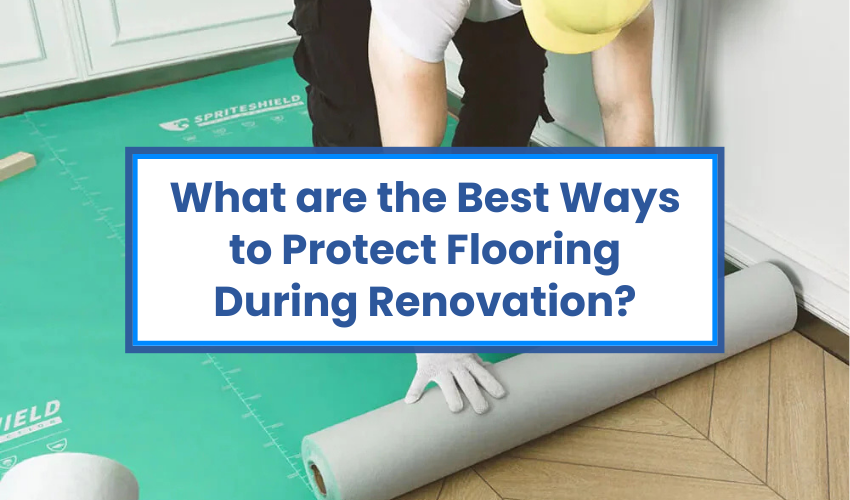Most people don’t take flooring protection as seriously during the renovation as they should. It’s the foundation of your entire house! A few scratches or stains can significantly impact your flooring appearance and value. And when it comes to renovations, the risks are even higher. Random paint spills, moving heavy furniture, and countless other things can damage your flooring.
So, if you are wondering how to protect flooring during renovation, this blog is especially for you. We will list some of the best tips.
Protective Measures You Must Not Neglect
Here are 3 essential protective measures that can make your flooring investment safe for years during the renovation:
-
Covering:
When you decide to make some changes in the room, such as new paint on the wall or drilling a hole to put scenery up there, covering your floor is probably an obvious thing to do to prevent it from getting dirty. You can use plastic sheets, drop cloths, or even old carpets to create a barrier between your floors and the renovation mess.
-
Furniture Removal:
If possible, move furniture out of the renovation area altogether. This will minimize the risk of scratches and dents on flooring. If you are single and can’t lift it, consider using furniture sliders to move it quickly. This way, you will protect your floors as you move heavy pieces without dragging.
-
Cleaning and Preparation:
Before starting the process, you must clean your floors to make them free from debris. This will help prevent damage and unwanted dust while renovating, making cleaning messes easier after renovation.
7 Essential Tips To Protect Flooring During Renovation
Here are some practical tips to protect your flooring during the renovation.
1. Create a no-shoe zone
Shoes, especially those with hard soles or high heels, can easily track in dirt, debris, and even small rocks. They can quickly put scratches on your existing flooring services. Additionally, construction workers’ shoes are a big NO; they might carry sharp objects like nails, screws, or pieces of metal on their boots. It increases the risk of further damaging your flooring.
For added convenience, we advise you to provide slippers or shoe covers for workers or visitors who need to enter the renovated space.
Pro Tip: Use signage to remind everyone entering the area that the no-shoe policy is in place. This small step can go a long way in preserving the cleanliness and condition of your flooring during the renovation process.
2. Use Protective Film for Hard Floors
A protective film is lightweight, self-adhesive, and specially designed for hard surfaces like wood, tile, and laminate flooring. It provides a waterproof barrier while sticking to the floor down below. It’s very easy just to roll out and remove when you’re done with it.
Pro tip: To avoid adhesive issues, make sure the film is meant for the type of floor you’re covering.
3. Cardboard Floor Protection (Ram Board)
Ram Board or heavy-duty cardboard is laid flat on the flooring, providing impact resistance and protection from debris and spills. It’s thick and durable, perfect for high-traffic areas where tools and equipment are being moved around.
Pro tip: Make sure to tape down the edges to prevent any severe damage.
4. Drop Cloths
Painters commonly use these large fabric sheets (often canvas) to catch spills and debris from the selected area during the renovation. They’re ideal for quick protection of flooring during smaller or less intense jobs. They’re easy to reposition, and the good part is that they’re reusable, too.
Pro tip: Use heavy-duty drop cloths to avoid tears if heavy tools are involved.
5. Foam Mats
Foam floor mats are often used in home gyms but work well to cushion and protect flooring from damage during renovations. It offers impact protection and can be used to create a padded workspace where heavy tools might be dropped.
Pro tip: These can be interlocked and moved around easily, making them ideal for covering large areas.
6. Plywood Sheets
Lay sheets of plywood over the floor, especially in areas with heavy machinery or where flooring might be subject to extreme pressure. Plywood disperses weight across a broader surface, preventing dents or scratches. It is perfect for protecting hardwood or tile floors during major renovation work.
Pro tip: Use thick plywood to ensure proper protection, especially if heavy furniture or appliances are being moved.
8. Rugs and Carpet Remnants
Old rugs or carpet remnants can be used as a barrier in areas where people are most likely to walk. It’s a cheap and effective solution for protecting floors during temporary or light-duty renovations.
Pro tip: Layer these rugs and carpets with other protection like film or cardboard for added durability.
What’s Next?
Once this renovation process takes place, it’s time to restore your flooring to its true essence. Following are the 3 main post-renovation care tips:
Remove Coverings
First and foremost, carefully remove protective coverings, taking care not to damage the flooring below. Take your time and gently peel away all the covers, especially around the edges and corners where they might be stuck.
Inspect for Damage
We are humans, and sometimes, we overlook small things. For that reason, it’s a good idea to re-check your flooring for any unnoticed scratches, dents, or stains once the final procedure is done. Address these issues immediately to keep your flooring investment safe for an extended time.
Deep Clean
After a renovation, you must see dust all over the place; it could be under the coverings, too, if not done correctly. Give your flooring a fine cleaning to restore its shine. For hardwood or tile, use appropriate cleaners to bring back the luster.
Pro Tip: Avoid harsh chemicals that can strip off protective coatings on hardwood or tiles. For wood or laminate flooring, consider reapplying a protective sealant or wax to enhance its durability and guard against future damage.
Final Words.
You now understand the best ways to protect flooring during renovation. Follow these steps to keep your flooring in pristine condition after the renovation. We would be more than happy to hear your insights about this blog. Drop a line in the comments below. If you have a question about a specific problem, feel free to ask!




